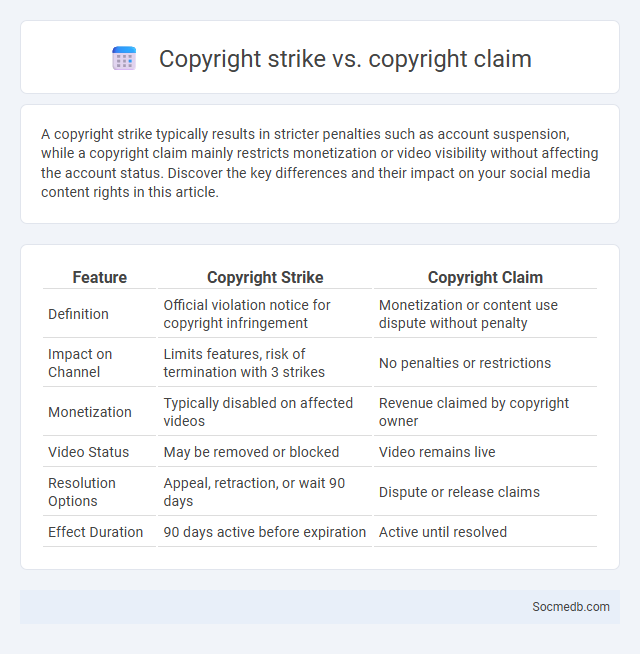
Photo illustration: Copyright strike vs Copyright claim
A copyright strike typically results in stricter penalties such as account suspension, while a copyright claim mainly restricts monetization or video visibility without affecting the account status. Discover the key differences and their impact on your social media content rights in this article.
Table of Comparison
| Feature | Copyright Strike | Copyright Claim |
|---|---|---|
| Definition | Official violation notice for copyright infringement | Monetization or content use dispute without penalty |
| Impact on Channel | Limits features, risk of termination with 3 strikes | No penalties or restrictions |
| Monetization | Typically disabled on affected videos | Revenue claimed by copyright owner |
| Video Status | May be removed or blocked | Video remains live |
| Resolution Options | Appeal, retraction, or wait 90 days | Dispute or release claims |
| Effect Duration | 90 days active before expiration | Active until resolved |
Understanding Copyright: Claims vs Strikes
Understanding the distinction between copyright claims and strikes on social media platforms is essential for content creators to protect their work while avoiding penalties. Copyright claims typically allow content to remain live with monetization redirected or limited, whereas strikes are serious violations that can result in account suspension or removal. Familiarizing oneself with platform-specific copyright policies and properly attributing third-party content can prevent misunderstandings and legal issues.
What Is a Copyright Claim?
A copyright claim on social media occurs when a user uploads content that includes copyrighted material without proper authorization, leading to a notice from the rights holder. Platforms like YouTube, Instagram, and Facebook use automated systems such as Content ID to detect and flag copyrighted audio, video, or images. These claims can result in content removal, monetization by the copyright owner, or account restrictions depending on the platform's policies and severity of infringement.
What Is a Copyright Strike?
A copyright strike occurs when a content creator on social media violates copyright laws by using protected material without permission, resulting in a formal complaint from the rights holder. Your account may face restrictions or removal if multiple strikes accumulate, signaling the platform to enforce stricter penalties. Understanding the implications of a copyright strike is crucial for maintaining your online presence and avoiding content takedowns.
The Function of the Copyright Strike System
The copyright strike system on social media platforms serves to protect intellectual property by monitoring and removing content that violates copyright laws, ensuring creators' rights are upheld. This mechanism helps maintain a fair digital environment by discouraging unauthorized use and promoting original content creation. You can mitigate risks by understanding the system's rules and promptly addressing any copyright claims.
Key Differences: Claim vs Strike
Claims and strikes in social media enforcement represent distinct levels of content violations, where a claim often involves copyright disputes without severe penalties, whereas a strike indicates a more serious breach, potentially leading to account restrictions or suspension. You should monitor claims carefully to avoid escalation into strikes, which can impact your ability to post or monetize content. Understanding these key differences helps safeguard your online presence and maintain compliance with platform policies.
How Copyright Claims Impact Creators
Copyright claims on social media platforms often lead to video removals, demonetization, or account suspensions, significantly affecting creators' revenue streams and audience reach. These claims can discourage originality, as creators may avoid using protected content even with fair use considerations due to automated detection systems. Navigating copyright laws and platform policies remains a critical challenge, making rights management tools and legal knowledge essential for sustaining content creation and protecting intellectual property.
Consequences of Receiving a Copyright Strike
Receiving a copyright strike on social media platforms can result in significant account restrictions, including removal of content, suspension of live streaming privileges, or temporary account disablement. Accumulating multiple strikes often leads to permanent account termination and loss of monetization opportunities. Content creators risk damaging their reputation and facing legal repercussions, severely impacting their digital presence and income streams.
How the Strike System Works on Major Platforms
The strike system on major social media platforms enforces community guidelines by issuing warnings and temporary suspensions for policy violations, escalating consequences with repeated offenses. Your account may face limitations such as content removal, reduced visibility, or permanent bans after accumulating multiple strikes within a specific timeframe. This system aims to maintain platform safety and discourage harmful behavior by monitoring user activity and enforcing consistent penalties.
Steps to Resolve Copyright Issues
To resolve copyright issues on social media, you should first identify the infringing content by reviewing your posts and notifications carefully. Next, submit a formal DMCA takedown notice to the platform, providing clear proof of ownership and a detailed description of the copyrighted material. You can also contact the infringer directly to negotiate a resolution or seek legal advice if necessary to protect your intellectual property effectively.
Best Practices to Avoid Claims and Strikes
To avoid claims and strikes on social media, you must consistently follow platform guidelines regarding copyright and content appropriateness. Use original content or obtain proper licenses for music, images, and videos to minimize infringement risks. Monitoring your account regularly and promptly addressing any disputes can protect your brand's reputation and ensure continued access to social media features.
 socmedb.com
socmedb.com